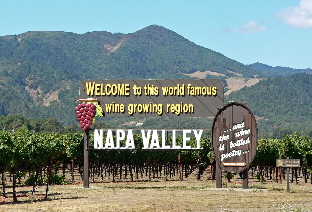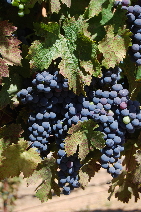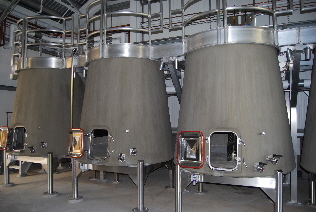
During our recent trip to Napa Valley and Sonoma Wine Country we met some fascinating people and learned more than we expected. Here are four take away bites we wanted to share with you.
1. It’s all about the Grape.
It’s easy to think about wine as something of a commodity much like Coke or Dr. Pepper. I like this. I don’t like that. So we forget about the farming aspect of winemaking. A poor winemaker can screw up great grapes, for sure. But there’s not much even the best winemaker can do with a poor grape crop. That was the fear this year in much of California including Napa and Sonoma. This grape crop was so questionable, due to a late spring that postponed bud break and a cool damp summer that retarded grape maturation, there was even talk of picking all the grapes in Napa early and scraping the entire harvest. The fear was the grapes would be so bad that the harvest could have a negative impact on Napa’s reputation for years to come. But cooler minds prevailed and the heat finally came, albeit very late, and harvest is well underway. These grapes probably won’t produce the “Best” of what Wine Country has to offer but we should see some good wines. Remember it may be wine in your glass, but it took a lot of farming and cooperation from Mother Nature to get it there.
2. What is Old is New Again.
The Romans, 2000 years ago, used concrete vessels to ferment wine. While the use of
concrete fermentation tanks never completely disappeared, particularly in Europe, they did fall out of favor only to be replaced by lighter and more hygienic steel tanks with superior temperature controls. Much like the 70’s fashions I see all over the mall, concrete tanks are making a comeback and are all the rage in some circles. These tanks are more technologically advanced than their forefathers, easily cleaned and temperature controlled but they are concrete. Some winemakers like Charlie Wagner at Mer Soleil feel it gives their Silver Chardonnay the richness and complexity of oak without adding any oak flavors. The new Kenzo Estate in Napa uses custom the designed concrete tanks seen here. Look for concrete tanks to become more widely accepted, especially in artisan winemaking circles.
3. It Doesn’t Take a Mega-Fortune to Make Great Wine
The biggest difference we’ve seen since our early sojourns to Napa nearly thirty years ago is the influx of those with mega-fortunes who want to make wine or at least own a wine label. While there are many that fit this description, an example is the newly opened Kenzo Estate. Owned by video game mogul Kenzo Tsujimoto, the winery and vineyards reportedly cost over $100 Million Dollars. Admittedly, it is a beautiful, refined and elegant facility with impeccable service, but does it take all that to make great wine? The answer is an emphatic, No! Certainly it’s easy to get sucked in to all the grandeur of wineries created by high tech and investment banking fortunes and if I’d made that kind of fortune, I might be there too. But when you visit, go up the back lanes and visit some of the smaller and historic producers. Meeting Randy Dunn of Dunn Howell Mountain Vineyards and Stu Smith of Smith-Madrone, both Napa pioneers from the ‘70’s, in their older, smaller, lower tech and quaint facilities was the highlight of this trip. Plus these guys, without tens of millions of dollars behind them, produce consistently awe inspiring wines. On the Sonoma side you find more small producers with smaller budgets. We have been impressed this year by the wines from Blanchard Family Wines who literally create their dream on a shoestring.
ago is the influx of those with mega-fortunes who want to make wine or at least own a wine label. While there are many that fit this description, an example is the newly opened Kenzo Estate. Owned by video game mogul Kenzo Tsujimoto, the winery and vineyards reportedly cost over $100 Million Dollars. Admittedly, it is a beautiful, refined and elegant facility with impeccable service, but does it take all that to make great wine? The answer is an emphatic, No! Certainly it’s easy to get sucked in to all the grandeur of wineries created by high tech and investment banking fortunes and if I’d made that kind of fortune, I might be there too. But when you visit, go up the back lanes and visit some of the smaller and historic producers. Meeting Randy Dunn of Dunn Howell Mountain Vineyards and Stu Smith of Smith-Madrone, both Napa pioneers from the ‘70’s, in their older, smaller, lower tech and quaint facilities was the highlight of this trip. Plus these guys, without tens of millions of dollars behind them, produce consistently awe inspiring wines. On the Sonoma side you find more small producers with smaller budgets. We have been impressed this year by the wines from Blanchard Family Wines who literally create their dream on a shoestring.
4. The Passion Remains
I am passionate about passionate people. No where on earth do you find more people excited about their work, their art and their lifestyle than in Wine Country. We saw it all over Napa and Sonoma. We tasted wines with some of the most passionate winemakers I’ve ever met, like Jean Hoefliger at Alpha Omega. Even Dolores Cakebread “Director of Ambience” at 80 years old is fiery in her passion for her namesake wines. But it’s not just winemakers. Its vineyard owners, cellar rats, servers in tasting rooms, shop owners, chefs and bartenders, they are all passionate. In both Sonoma and Napa passion lives at every turn and it feels good to be a part of that energy. There is no doubt that living in Wine Country has it challenges, like high cost of living and housing, but the folks we met found it a small price to pay to live their dream.


[…] Subscribe to the comments for this post? […]
hi!This was a really fine theme!
I come from milan, I was fortunate to approach your topic in google
Also I obtain much in your Topics really thank your very much i will come every day
Hey, I can’t view your site properly within Opera, I actually hope you look into fixing this.
Hope to meet the Blanchards some day. Very interesting people. Enjoyed learning about the concrete tanks.
Emphasis on bullet #3. Sure, starting with $10 million dollars is great, but it spoils you. Scraping by for every sale to pay the monthly bills makes you appreciate your trade more and strive for an even better product each year. We at Blanchard Family Wines have an annual budget of what Kenzo probably spends to keep the lights on in their fermentation room, but we continue to press for improvements. We will drain the bank account to purchase our new French oak barrels this year and the highest quality grapes we can get our hands on, and hope for success once again. Our 2010 harvest is looking better than many others and we hope we can keep the doors open and lights on until we can get this product to market.